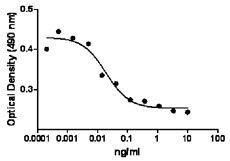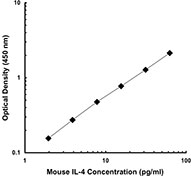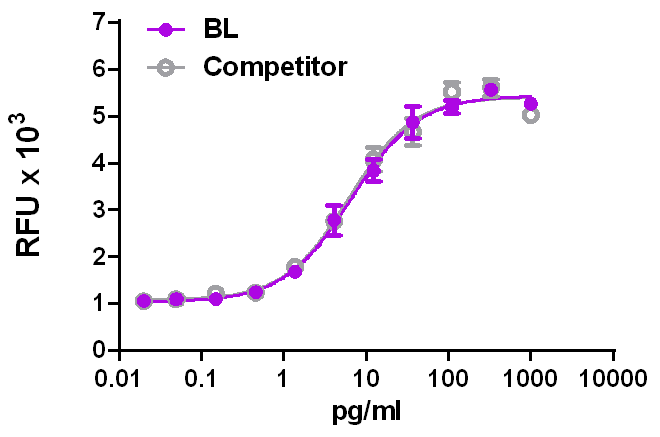- Regulatory Status
- RUO
- Other Names
- IL-6RA, CD126, IL6RA
- Ave. Rating
- Submit a Review
- Product Citations
- publications

-

Human IL‐6Rα enhances the IL‐6 mediated growth arrest in myeloid leukemia M1 cells. BioLegend’s protein was compared side‐by‐side to a competitor’s equivalent product.
IL-6 is a cytokine that plays multiple roles in inflammation, acute phase response, hematopoiesis, and regulation of the immune system. IL-6 binds to IL-6Rα with nanomolar affinity. The complex IL-6/IL-6Rα triggers dimerization of gp130, in which the receptor-ligand interaction induces the signal transduction though the JAK/STAT pathway. gp130 is also a receptor subunit for IL-11, CNTF, LIF, OSM, CT-1, CLC, and IL-27. gp130 is ubiquitously expressed in different types of cells. Nevertheless, gp130 does not bind IL-6 nor IL-6Rα, thus cells only expressing gp130 are unresponsive to IL-6. IL-6Rα and gp130 have soluble forms. Soluble IL-6Rα (sIL-6Rα) is generated by two mechanisms: by shedding from the membrane and by translation of a differentially spliced RNA. Cells expressing only gp130 can be responsive to the complex of IL-6/sIL-6Rα, and this process has been named trans-signaling. Inflammatory processes induce the shedding of IL-6R from neutrophils, and the complex IL-6/sIL-6Rα activates endothelial cells to produce MCP-1, which attracts monocytes. Soluble gp130 (sgp130) can be found in a ternary complex with IL-6 and sIL-6Rα, and it has been suggested to be the natural inhibitor of sIL-6Rα. Increased levels of sIL-6Rα have been detected in colitis, arthritis, and idiopathic pulmonary fibrosis. In vivo neutralization of sIL-6Rα attenuated pulmonary fibrosis in mice.
Product DetailsProduct Details
- Source
- Human IL-6Rα, amino acids (Leu20-Asp358) (Accession# NM_000565), was expressed in insect cells.
- Molecular Mass
- The 339 amino acid recombinant protein has a predicted molecular mass of approximately 38.7 kD. The protein migrates at approximately 58 kD in DTT-reducing conditions and at 54 kD in non-reducing conditions by SDS-PAGE. The predicted N-terminal amino acid is Leu.
- Purity
- >95%, as determined by Coomassie stained SDS-PAGE.
- Formulation
- 0.22 µm filtered protein solution is in PBS, pH 7.2
- Endotoxin Level
- Less than 0.01 ng per µg cytokine as determined by the LAL method.
- Concentration
- 10 and 25 µg sizes are bottled at 200 µg/mL. 100 µg size and larger sizes are lot-specific and bottled at the concentration indicated on the vial. To obtain lot-specific concentration and expiration, please enter the lot number in our Certificate of Analysis online tool.
- Storage & Handling
- Unopened vial can be stored between 2°C and 8°C for up to 2 weeks, at -20°C for up to six months, or at -70°C or colder until the expiration date. For maximum results, quick spin vial prior to opening. The protein can be aliquoted and stored at -20°C or colder. Stock solutions can also be prepared at 50 - 100 µg/mL in appropriate sterile buffer, carrier protein such as 0.2 - 1% BSA or HSA can be added when preparing the stock solution. Aliquots can be stored between 2°C and 8°C for up to one week and stored at -20°C or colder for up to 3 months. Avoid repeated freeze/thaw cycles.
- Activity
- ED50 = 3.0 - 15 ng/ml, as determined by the ability of IL-6Rα to increase the growth arrest on mouse myeloid leukemia M1 cells induced by human IL-6 (20 ng/ml).
- Application
-
Bioassay
- Application Notes
-
BioLegend carrier-free recombinant proteins provided in liquid format are shipped on blue-ice. Our comparison testing data indicates that when handled and stored as recommended, the liquid format has equal or better stability and shelf-life compared to commercially available lyophilized proteins after reconstitution. Our liquid proteins are verified in-house to maintain activity after shipping on blue ice and are backed by our 100% satisfaction guarantee. If you have any concerns, contact us at tech@biolegend.com.
- Product Citations
-
Antigen Details
- Structure
- Monomer, soluble receptor.
- Distribution
-
IL-6Rα is expressed in hepatocytes, neutrophils, macrophages, and lymphocytes. Soluble IL-6Rα is present in body fluids (urine and blood).
- Function
- Soluble IL-6Rα plays a key role in IL-6 trans-signaling, which is a process that allows the response to IL-6 on cells that do not express IL-6Rα. It increases the polarization of Th17 by IL-6. It is produced by proteolysis by ADAM17. Its shedding is induced by PMA, IL-1β, TNF-α, and apoptosis.
- Interaction
- Endothelial cells and a variety of cells expressing gp130.
- Ligand/Receptor
- IL-6 and sIL-6Rα/IL-6 complex bind cells expressing gp130.
- Bioactivity
- IL-6 promotes the growth arrest and differentiation of mouse myeloid leukemia M1 cells, and this effect is enhanced by sIL-6Rα.
- Cell Type
- Hematopoietic stem and progenitors
- Biology Area
- Cell Biology, Immunology, Innate Immunity, Neuroinflammation, Neuroscience, Signal Transduction, Stem Cells
- Molecular Family
- CD Molecules, Cytokine/Chemokine Receptors, Soluble Receptors
- Antigen References
-
1. Jostock T, et al. 2001. Eur. J. Biochem. 1:160.
2. Saito T, et al. 1991. J. Immunol. 147:168.
3. Vermes C, et al. 2002. J. Biol. Chem. 277:16879.
4. Kamimura D, et al. 2003. Rev. Physiol. Biochem. Pharmacol. 149:1.
5. Matthews V, et al. 2003. J. Biol. Chem. 278:38829.
6. Chalaris A, et al. 2007. Blood 110:1748.
7. Le TT, et al. 2014. J Immunol. 7:3755. - Gene ID
- 3570 View all products for this Gene ID
- UniProt
- View information about IL-6Ralpha on UniProt.org
Related FAQs
- Why choose BioLegend recombinant proteins?
-
• Each lot of product is quality-tested for bioactivity as indicated on the data sheet.
• Greater than 95% Purity or higher, tested on every lot of product.
• 100% Satisfaction Guarantee for quality performance, stability, and consistency.
• Ready-to-use liquid format saves time and reduces challenges associated with reconstitution.
• Bulk and customization available. Contact us.
• Learn more about our Recombinant Proteins. - How does the activity of your recombinant proteins compare to competitors?
-
We quality control each and every lot of recombinant protein. Not only do we check its bioactivity, but we also compare it against other commercially available recombinant proteins. We make sure each recombinant protein’s activity is at least as good as or better than the competition’s. In order to provide you with the best possible product, we ensure that our testing process is rigorous and thorough. If you’re curious and eager to make the switch to BioLegend recombinants, contact your sales representative today!
- What is the specific activity or ED50 of my recombinant protein?
-
The specific activity range of the protein is indicated on the product datasheets. Because the exact activity values on a per unit basis can largely fluctuate depending on a number of factors, including the nature of the assay, cell density, age of cells/passage number, culture media used, and end user technique, the specific activity is best defined as a range and we guarantee the specific activity of all our lots will be within the range indicated on the datasheet. Please note this only applies to recombinants labeled for use in bioassays. ELISA standard recombinant proteins are not recommended for bioassay usage as they are not tested for these applications.
- Have your recombinants been tested for stability?
-
Our testing shows that the recombinant proteins are able to withstand room temperature for a week without losing activity. In addition the recombinant proteins were also found to withstand four cycles of freeze and thaw without losing activity.
- Does specific activity of a recombinant protein vary between lots?
-
Specific activity will vary for each lot and for the type of experiment that is done to validate it, but all passed lots will have activity within the established ED50 range for the product and we guarantee that our products will have lot-to-lot consistency. Please conduct an experiment-specific validation to find the optimal ED50 for your system.
- How do you convert activity as an ED50 in ng/ml to a specific activity in Units/mg?
-
Use formula Specific activity (Units/mg) = 10^6/ ED50 (ng/mL)

 Login / Register
Login / Register 












Follow Us